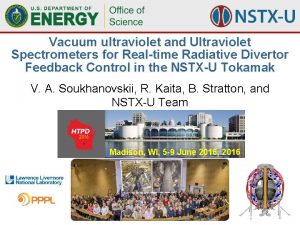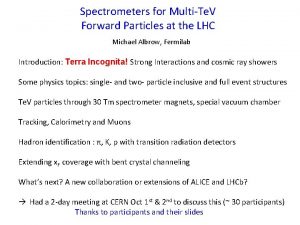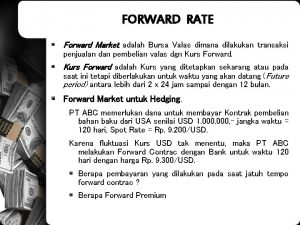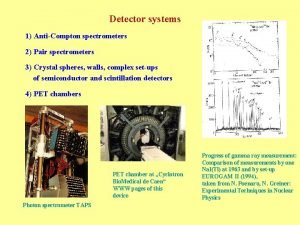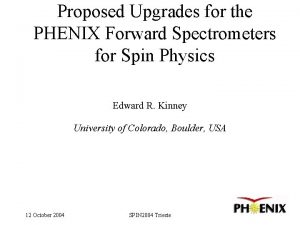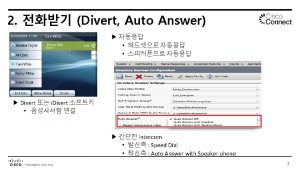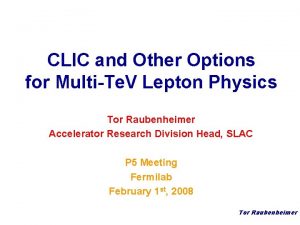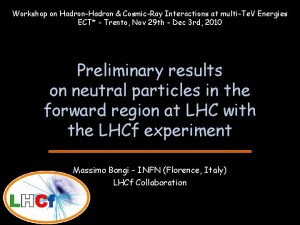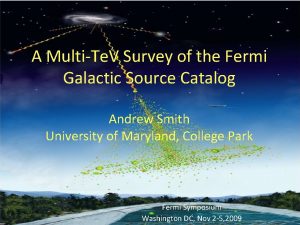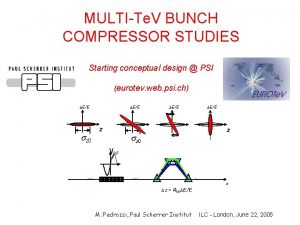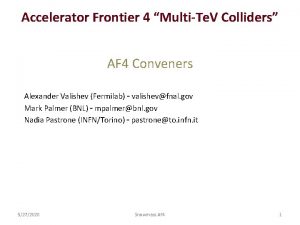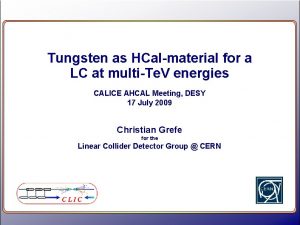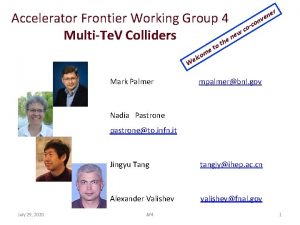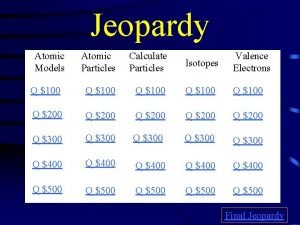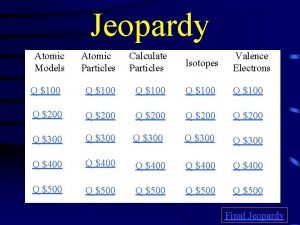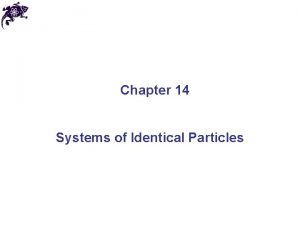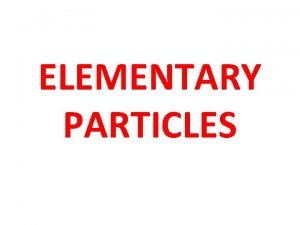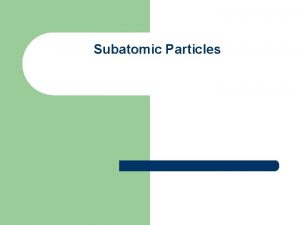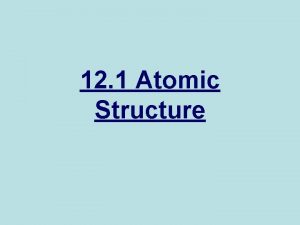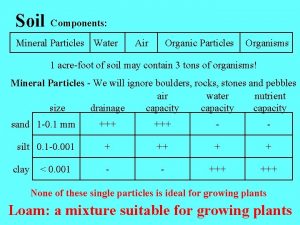Spectrometers for MultiTe V Forward Particles at the



























































- Slides: 59

Spectrometers for Multi-Te. V Forward Particles at the LHC Michael Albrow, Fermilab Introduction: Terra Incognita! Strong Interactions and cosmic ray showers Some physics topics: single- and two- particle inclusive and full event structures Te. V particles through 30 Tm spectrometer magnets, special vacuum chamber Tracking, Calorimetry and Muons Hadron identification : π, K, p with transition radiation detectors Extending x. F coverage with bent crystal channeling What’s next? A new collaboration or extensions of ALICE and LHCb? Had a 2 -day meeting at CERN Oct 1 st & 2 nd to discuss this (~ 30 participants) Thanks to participants and their slides

ROMAN POTs ATLAS, CMS, etc Terra Incognita Last explored at ISR at √s = 63 Ge. V, 200 x lower All fixed target experiments < ISR (≅ 2000 Ge. V FT) y(π) = 10 ZDC, LHCf measure neutrals (n, π0 γγ) at very small angles. y(π) = 11

Idea, using 10 – 15 m of space in front of TAN: Use MBX dipoles (Integral B. d. L ~ 30 Tm) as spectrometer magnets. Use straight section from ~ 85 m to 140 m (TAN absorber) space. Special vacuum chamber design for particles to emerge through minimal material Precision tracking (silicon strips or pixels) over a 2 m (θx, θy to a few μrad) Transition Radiation Detectors for γ = E/m in 103 – 3. 104 region Hadron Calorimeter for energy measurement Muon tracking behind calorimeter Bent crystal to channel and so accept highest momenta (>~ 4. 5 Te. V, ~4 mrad bend)

x. Feynman = x. F = p(hadron)/p(proton) x. F – x. Bj relationship, but less direct than in deep inelastic scattering. x. Bjorken = x. Bj = p(parton)/p(proton) Major industry at HERA, and these PDFs Needed for hard (partonic) interactions at LHC E. g. p π+ is from leading u adding a dbar p π- is from leading d adding a ubar Ratio at high x reflects u: d in p u u u d d, c, bbar d Leading π+, D 0, B+ (? ) u d, c, b t-channel baryon exchange (Reggeized) Not measured for x. F at √s > 63 Ge. V

COSMIC RAY SHOWERS: ASTROPHYSICS CONNECTION Lipari, SAS@LHC Knee Intermediate region ISR-63 Ge. V Ankle LHC-13 Te. V x 200 in √s = x 40, 000 in FTE AUGER GZK Cut-off

√s = 45 Ge. V, CHLM (MGA inter alia) SAS @ ISR Nucl Phys B 140 (1978) 189 37 years ago !

Challenge to theorists Strong Interactions at low-Q 2 Hadron level ~ Regge theory Parton level ~ QCD (non-perturbative) Leading (high x. Bj) u-quark or [ud] di-quark picks up an sbar or s in “string-breaking” or from s-sbar sea, to make a leading K+ or Λ 0, Σ 0 γcτ(Λ) at 4. 4 Te. V is 316 m, pπ- (acceptance? ). Σ 0 --> Λ 0 + γ (100%, prompt) Quark line description of leading K+ or Λ 0, Σ 0 Virtual (negative mass 2, t-channel) exchanged baryon or meson described in Regge phenomenology : Analyticity, unitarity and crossing symmetry + continuous complex angular momentum. Derive it from QCD !! ?

COSMIC RAY SHOWERs Simulated UHE Cosmic ray shower over Auger observatory in Argentina ICECUBE Event 20 : 1140 Te. V ν PMTs in Antarctic ice, 1 km 3 Simulating showers relies on particle production cross sections that are MUONS ! not well known Water Cherenkov tanks ~ 1 km spacing One day : p-N and N-N collisions ?

1017 e. V Forward charm can be measured more directly in SAS@LHC

Notes: At 0. 5 Te. V (~ central) π+ = π- & K+ ≅ K- & K/π ~ 10% p’s > π+ above 1. 5 Te. V and flattish; High x. F peak from diffraction K-(s-ubar) steeper than K+ (sbar-u) π- (d-ubar) steepler than π+ (u-dbar) Antiprotons < K- but only by a factor ~ 0. 5 ~ 100 x Acc/bin/sec if μ ~ 3 In 1 second, with 2808 bunches, Have 30 x 106 bunch crossings and 30 x 106 x μ(= interactions/X) events. Number per 125 Ge. V/c bin Spectra generated by /DPMJET-MARS With 106 pp events, √s = 13 Te. V (N. Mokhov and O. Fornieri) Number per 125 Ge. V/c bin DPMJET prediction Could be quite differerent!

Neutral particles from collisions at 13 Te. V : DPMJET predictions Measured in LHCf, ZDC. Very different from charged particle spectra SAS@LHC would have a hadronic calorimeter (EM showers in TRD) Can be much better than LHCf ZDC with e. g. higher granularity, better containment

LHCf is a small 0 o calorimeter measuring photon-like and n-like showers Only 1. 6 λI and 4 cm in size, σ(E)/E ~ 40% for neutrons. To illustrate the large spread in predictions even at much lower √s (900). ZDC in CMS 7 λI and 8 cm x 10 cm Expect σ(E)/E ~ 15% at 3 Te. V A good 3 D-imaging calorimeter for SAS : σ(E)/E ~ 5%

Example of spread in Cosmic ray shower simulations # muons on ground / E 0. 9 (to flatten curves) vs E. p- Air (solid) and Fe- air (dashed) From FPWG_YELLOW_REPORT : CERN/LHCC 2013 -021 These are on air not pp. LHC has also run p-Pb and Pb-p and SAS could take data there. What about p-N and N-N? Such special running may (should) become more acceptable in future. Heavy ion groups (ALICE et al) would support this. Equivalent FT energy of √s = 13 Te. V E≅ = s/2 mp Big spread even assuming no surprises, e. g. high forward heavy flavor production

200 inelastic collisions at Pt 5 ( 13 Te. V, β* = 0. 55 m): MARS If μ = 1 this is 200 bunch crossings = 6 μs TOP VIEW Nikolai Mokhov Ottavio Fornieri Scale factor x: z = 486: 1 Negatives From interaction Λ pπ- Positives Hitting pipe: 2 π- and 4π+ and about 8 protons / 200 collisions. Mostly near horizontal plane

MARS simulation (Nikolai Mokhov and Ottavio Fornieri (summer intern)) For Pt. 5 (CMS) with β* = 0. 55 m : need to do for β* = 5 m at at LHCb, ALICE Looking along 20 cm diam beam pipe: only particles inside pipe shown, at 3 distances - ves + ves 2 Te. V – 3 Te. V particles These all exit pipe between 107 and 131 m >> Only need to cover ~ 10 cm in y on L and R sides, not all ϕ

Particle transport calculations (Pt. 5, β* = 0. 55 m) using MAD files Outgoing p beam Jerry Lamsa Positive particles contained in 40 cm diam pipe. Only +/- 5 cm in y needed for p. T <= 0. 4 Ge. V/c Negatives on left side (not shown) Less y coverage adequate (focusing) x, y, θx and θy needed for p. T, pz, ϕ Calculations shown are for Pt. 5 and specific optics. At Pts 2 and 8, larger β* and different, need specific calculations. Ellipses for p. T = 0. 4 Ge. V/c, all ϕ. For single particle inclusive spectra do not need full ϕ – coverage, but valuable for correlations

On both sides of Point 5 (CMS) we installed Forward Shower Counters FSC As “rapidity gap” detectors in low pile-up diffractive collisions. Simple (scintillators + PMTs) and information limited to showering particles. MBX beam separation dipoles on Right Start of 50 m 20 cm diam pipe on left. Half way along, FSC-2. Concrete shielding walls can be adapted if necessary LHCb system “HERSCHEL” (Paula Collins inter alia ) Points 2 (ALICE) AND/OR 8 (LHCb) more appropriate (Low PU, physics focus, Heavy Ions)

Beam pipe design for small angle spectrometer (schematic) (Jerry Lamsa) 50 cm (? ) diameter pipe from 85 m to 130 m (from collision) 40 mm thin window (Be? Al? ) Minimize scattering/imteractions Benoit Salvant talk 10 -15 m for detectors TOP VIEW 50 cm VACUUM Inner thin foil or wire grid ~ 40 m large pipe 50 cm diam pipe +ves -ves i. NCOMING BEAM OUTGOING BEAM

ALICE : Already have a large conical beam pipe for ZDC > Centrality etc measurements in Heavy Ion (Pb+Pb) collisions TOP VIEW ZDC 70 cm ZDC Make space in front of calorimeter (with “thin” window) for tracking, TRDs, and behind calorimeter for muon measurement. Muons 1 m Calorimeter 2. 5 m ------TRD-----6 - 8 m Tracking 2 m particles total = 12 - 15 m

SAS as a Multi-particle Spectrometer Acceptance for 2 or more particles from same event. Positive and negative particles on opposite sides of pipe, near horizontal plane. Acceptances need to be calculated … may be small or zero for some particles But potentially: J/ψ, ψ(2 S) μ+μ-, χc J/ψ + γ, Drell-Yan μ+μ- , γγ μ+μK 0 s π+π-, Λ p π D 0 K+π- … χc π+π, K+K-, etc. Very forward charm and beauty also measured with single leading e and μ Leptons can be identified (how well? Background from fakes? ) Leptons from π, K decay will be known, and their decay lengths are very long! γcτ (π) = 340 km at 2. 5 Te. V ! Just a thought: Bose Einstein Correlations Two same-sign pions (or kaons) close in phase space Correlation (excess) width size of emission region At θ ~ 0 transverse size (overlap) Interest in heavy-ion collisions … maybe pp too Correlate with central event. + D + Small Δp ~ 1/D

Heavy – ion collisions (ALICE Specialty) So far : p + Pb and Pb + Pb, with p + p in ALICE as “control” to study changes. One day (feasible) : p + N and N + N as in atmosphere Must be many interesting studies to do with SAS. Here just two off “top-of-the-head”: Head-on view Jets this way quenched Nuclear fragments: d, t, He 3, He 4, Li… Bose-Einstein correlations between π+π+ & π-π- close in momentum measure size of pion emission region. Directional: correlate with φ(jets) Jets this way emerge not quenched down beam pipe π π PRL 105 (2010) 029 PL 129 B (1983) 269 (R 807, AFS)

ALICE has pp collisions “for free” for most of the LHC running Cannot compete with ATLAS and CMS for high mass/high p. T pp physics Luminosity/pile-up much lower (good for SAS) and appropriate detectors. Focus (pp) is on high multiplicity events, particle correlations, heavy flavor at low p T … Can have unique strong interaction program with SAS (maybe competing with LHCb) LHCb focus is on charm and beauty, forward (but not this forward) Also low PU (good) with β* = 5 m (not 0. 55 m) SAS extends spectrometer to y ~ 8, 9 Acceptances not yet calculated but will be (Gianluca Cavoto inter alia). SAS

Tracking Precision tracking immediately behind (thin!) vacuum pipe window (Be? ) No field so straight tracks. x, y, dx/dz, dy/dz at z σ(x, y) = 10 μm over 2 m -> 5 μrad Cf bend of 6. 5 Te. V proton ~ 1500 μrad Θ = 0. 3 B. L(Tm) / p (Te. V/c) Projection of track back momentum dp/p < ~ 0. 5% if from primary vertex. Can be matched with energy from calorimeter if hadron Background from showers in upstream pipe etc. can be reduced or even eliminated. Tracking measures |Q| also. [x 0, y 0, z 0, px, py, pz] at collision [x, y, θx, θy, E = p] at z (Q known)

Tracking is a solved problem, many solutions, much experience Probably silicon strips (low occupancy) in 3 orientations, or pixels, standard technology. 3 D silicon rad hard, “edgeless” probably good solution. Not yet “off the shelf” but being developed, by end 2016 could be standard. Non-3 D is standard now. About 12 planes e. g. 4 triplets ? Two tracking stations on + and – sides, Area ~ 10 cm x 10 cm. Only ~ 0. 2 m 2, latch on to an order from the big experiments like CMS? This could provide a level 1 trigger requiring a track through, and could “look up” px, py, pz or p. T, pz if desired in simple fast trigger processor. 3 D silicon: Columns front-back Drift is sideways. Planned for CT-PPS etc. Particles

Calorimeters Wanted for energy measurement Complements tracks Δp/p ~ 1% if 1 ry , and ΔE/E ~ 5% probably achievable. Follow track upstream with p = E to z = 0. Primaries have x = y = 0 at z = 0, background not. EM : probably not useful behind TRD (a few X 0 already … TRD as ECAL? ) HADronic sections … can be very deep (even 3 m); λI(W) = 10 cm – good muon filter Can profit from major developments in high granularity calorimeters But our modules much smaller (protoype test module size)

Calorimeter Example 1 Or just keep this Discard this part Eva Sicking’s talk

Test beam data and predictions Eva Sicking’s talk Highly granular 3 D information Details of 3 D “shape” help correct for side leakage (only on pipe side) (side-catcher? )

Eva Sicking’s talk

Eva Sicking’s talk Tungsten Scintillator Calorimeter 2. 5 – 3 m deep should be fine, and σ(E)/E ~ 5%

Slawek Tkaczyk’s talk Much harsher environment , very high pile-up, energy density/25 ns, mechanical constraints, Hard to access operation for ~ a decade. A very big effort developing. $$$ SAS ~ test beam prototype. “Maybe we could get one? ”

Slawek Tkaczyk’s talk

Slawek Tkaczyk’s talk Test beam modules : Hanging file design Very versatile if flexibility desired (Can change configuration, insert special layers, etc. Could be appropriate for SAS. Two support rails for each of the two modules. A major complication for CMS is cooling, as Calo in confined space. ir. n SA oli o c S er l p g sim a d l o c w o l : b

A good hadron calorimeter, compact (tungsten plates) to minimise lateral leakage can be made in ~ 2. 5 m of longitudinal space. Sampling can be with scintillator tiles or bars, silicon pads, or “other” … Readout of scintillator can be with PMTs or (now cheap and fast) Si. PMs Could include special imaging layers (micromegas? ) if useful. As occupancy low, and we know from tracking where charge particles enter, bars (e. g. 1 cm x 20 cm x 5 mm) in an x-y or u-v-x layer arrangement OK. >> Fewer channels for higher spatial resolution in projections. If SAS taken up by ALICE or LHCb they already have calorimeters, may “simply add”. CALORIMETRY for SAS can be done

Muon Measurement behind calorimeter Muons : from primary collision: Drell-Yan pairs, photo-produced J/ψ, ψ(2 S), Υ 1, 2, 3 and γγ μ+μ- (especially in AA) Some acceptance for measuring both! What is it? Almost prompt, from c, b decays. Note BR ( D 0 μ + X) = 6. 7% Background from π, K etc decays. γcτ(π) at 2. 8 Te. V = 150 km, . γcτ(K+) = 70 km Background from upstream interactions in pipes etc. Momentum from upstream tracking, penetration and energy loss (fn(E)) through calorimeter TRD signals consistent with m = p/γ = m(μ) (= m(π) , no separation. HERE

Muon Detectors … also punch-through monitoring + Background from π or K decay. Lifetimes very long: γcτ(π/K) at 2. 8 Te. V = 150/70 km But we measure π and K spectra and know this well. Background from upstream interactions in pipe, materials; tracking (& E) should eliminate this. Area should match calorimeters, so ~ 20 cm x 30 cm on each side. Simply to require a crude “track” matching the upstream detectors (tracking + TRD) Probably σ(x, y) ~ 5 mm is fine, and about 1 – 2 m long* There are many established technologies. This one (Dzero): has ~ 2 cm “toblerone” bars with WLS fibers, can have Si. PM at each end. Pulse height sharing x coord. 3 views u, v, x at front and back of 1 – 2 m space. If done with ALICE / LHCb they have technologies: RPCs with Cathode pads, MWPCs and triple-GEMs

Charm and beauty hadrons only measured at LHC in central region. Some models, e. g. Stan Brodsky “intrinsic heavy flavor” have enhanced forward Q production -- Massive Quarks in sea carry high momentum for same rapidity (At p. T = 0 x. F = m. ey / √s) c, b μ gives excess prompt muons at large x. F. In Δx = 0. 1 at x = 0. 4 about 10 -3 per inelastic event. At PU = 1 have 30 million X/sec : ~ 104 μ/s ! μ?

Transition Radiation Detectors - TRD Probably only technique for distinguishing π / K / p at multi-Te. V energies Interesting challenge far beyond usual e/π separation Half day parallel session on TRD developments and prospects 2 -Day Meeting on SAS@LHC, CERN, Oct 1 + 2


E 769 (Jeff Appel inter alia) used TRDs to distinguish beam particles and measure fwd charm

Technical challenge: Identification of multi-Te. V π/K/p Mike Cherry Cherenkov counter cannot as “β = 0. 999” for all. Only game in town: Transition Radiation Detectors TRD Interface between two materials different ε X-ray emission ~ 1/137 but prop-to γ = E/m Know E = p from tracking and calorimeter, hence m. Fastest hadrons in SAS ~ 5 Te. V π; γ = 5000/0. 14 ~ 3. 6 104 Slowest in SAS ~ 1 Te. V p; γ = 1000/0. 94 ~ 1. 1 103 Can “tune” design es s for γ – range : higher γ longer In In cre cr as ea in sin g f g g oil ap thi s ckn In PDG 5 Te. V π 1 Te. V p RANGE

Identification of π/K/p : Main technology challenge! (Crystals are too) Transition radiation at interfaces between Materials of different dielectric constant measure γ = E/m (E from calorimeter) 10 % measurement of γ with 5% measurement of E good separation Dolgoshein 4. 2 Te. V π 6 Te. V p Mike Cherry

Note: To measure single hadron inclusive spectra do not need 5%/10% separation! Example from CDF Drift chambers of d. E/dx ionization measurement in one p-bin (400 Me. V/c) NOTHING TO DO WITH TRD! JUST TO MAKE A POINT π K Fit composition for all p-bins spectra. (Also pile-up irrelevant. ) p (d) Better separation needed to do correlations e. g. M(Kπ) … D 0? and with central event, e. g. : K± TRDs in SAS, like other detectors, accessible and replaceable as improved

In principle can also detect Compton scattered X-rays on sides of radiator stack: Another old idea, now perhaps feasible with new detectors (e. g. micromegas): Mike Cherry

TRD also provides precision traking information! Mike Cherry, Louisiana State Univ. , summary talk

Acceptance for higher x. F ~ 0. 7 – 0. 9 Bent crystal channeling Large area of research, annual international conferences etc. Needed to cover x. F > ~ 0. 8 – 0. 9 region, otherwise down beam pipe. Intercept particles close to beam at around 90 m with long (~ 12 cm? ) crystal with 4 – 5 mrad deflection. Inside vacuum chamber, position and angle steering. Developments over years, for beam collimation and also extraction (AFTER) In principle : SAS study interactions of Te. V identified mesons. UA 9 Experiments W. Scandale, G. Cavoto inter alia (UA 9 collaboration … tests in SPS, LHC) Protons probably > 99% at x. F = 0. 9. Into diffractive proton region for high mass and high-t (acceptance? ) Study heavy flavors in high-mass diffraction e. g. in central detector. (Low mass diffraction e. g. p p π+π- may be studied inside SAS) And rarest high-x mesons may be most interesting!

Bent crystal here An extra 3 -5 mrad kick Pipe shown at 10 cm radius (as now at Pt. 5) but will be larger (~ 25 cm? )

Extension of x. F acceptance towards x. F ~ 0. 9 (or more? ) Gianluca Cavoto (INFN Roma)

Channeling 980 Ge. V beam!

1994 Gianluca Cavoto (INFN Roma)

UA 9 is an on-going project studying beam halo collimation and extraction, in SPS and in 2016 inside LHC beam pipe. Use for SAS interesting, challenge “Anticlastic bending” of crystal. Goniometers inside LHC vacuum pipe Move in x, y, θx, θy to cover phase space Acceptance very small (μrad) Deflection angles ~ 1 mrad OK, 4 -5 mrad? Several in series possible. Positive particles only channeled. No change in |p|, only angle. Gianluca Cavoto (INFN Roma) Photo of SPS pipe assembly

Fermilab involvement ? ? Fermilab stretched for money and manpower with neutrinos, CMS, other … Do not expect much … but a little can still be significant! We have history and expertise in ~ all aspects: Auger UHE cosmic ray showers Event generation and track/beam line modeling (Mokhov et al. , DPMJET + MARS) Should do acceptance etc. studies also for Pts 8 and 2 (person-power) Crystal channeling Transition radiation detectors Tracking (Si, pixels, 3 D … ) and muon chambers And: Calorimetry : CMS HGCAL for upgrade ; SAS could be a perfect place for a small “test beam” or prototype module, installed in the LHC earlier (2017? ) to get operational experience and do physics.

Summary Terra Incognita : large phase space (in x. F, p. T) unexplored from √s = 63 – 13, 000 Ge. V ! Justification in itself, but … Need to understand Strong Interaction in non-perturbative sector Important to understand UHE cosmic rays : Sampled shower primary, UHE collisions, muons Spectrometer magnets and 85 m vacuum chamber + 55 m straight section exist. Need special vacuum chamber with thin exit windows. Feasible. Technology for tracking, calorimeter, muon tracking exist, small area & can use the best! Particle ID with transition radiation possible (π, K, p) … interesting challenge to improve. Bent crystal channeling to extend x. F – coverage possible … interesting challenge to improve. Open & accessible & small so evolution of techniques natural. How and where? Want many months of running with low pile-up: Pt. 1 (ATLAS) and Pt. 5(CMS) not good. Pt. 8 (ALICE) and Pt. 2 (LHCb) have best conditions and better alignment with physics. Both should find addition of SAS enhances their physics program, both pp and nuclei Or : Independent new experiment (expect later merger) In any case : TRD experts will develop suitable TR detectors Crystal channeling experts are developing Xtals. A milestone: Workshop in May, Italy on forward physics at LHC It should be done and it can be done!

Thank You Back Ups

Broad rapidity coverage in ALICE (here Pb-Pb) http: //arxiv. org/pdf/1509. 07299 v 1. pdf Added value for HI collisions: measure nuclear fragments (d, t, He 3, He 4, …) Better centrality measurements, forward flow, …

Beam pipe design (first try, very schematic) 20 cm diameter pipe from 85 m to 140 m (from Point 5) Eight flared units from z = 90 m to 130 m 25 mm thin window (Be? Al? Minimize scattering/imteractions Benoit Salvant talk θ = 5 mrad flare VACUUM 20 cm Inner thin foil or wire grid … maybe not needed? 5 m flared pipe unit 20 cm diam pipe ~ 40 mm -ves i. NCOMING BEAM +ves OUTGOING BEAM

Agenda: Thursday morning plenary. Meeting : informal, discussions No speaker? (probably not)

Thursday afternoon parallel session

Parallel Session: Workshop on TRDs for SAS

Friday Oct 2 nd Plenary Regular meetings to develop plans. Workshop on Forward LHC Physics, Italy in May Stand-alone : : : ALICE extension : : : LHCb extension ? ? (Effort, money, politics, … )
 Vacuum uv spectrometers
Vacuum uv spectrometers Covie
Covie Rumus forward rate
Rumus forward rate Forward market adalah
Forward market adalah Datorkunskap för nybörjare
Datorkunskap för nybörjare Magnetsjukhus
Magnetsjukhus Ellika andolf
Ellika andolf Blomman för dagen drog
Blomman för dagen drog Vad står k.r.å.k.a.n för
Vad står k.r.å.k.a.n för Redogör för vad psykologi är
Redogör för vad psykologi är Bästa kameran för astrofoto
Bästa kameran för astrofoto Mat för idrottare
Mat för idrottare Geometri för barn
Geometri för barn Publik sektor
Publik sektor Upprepning i prosa
Upprepning i prosa Ledarskapsteorier
Ledarskapsteorier Antikt plagg i rom
Antikt plagg i rom Tidbok för yrkesförare
Tidbok för yrkesförare Vilken grundregel finns det för tronföljden i sverige?
Vilken grundregel finns det för tronföljden i sverige? Steg för steg rita
Steg för steg rita Kontinuitetshantering i praktiken
Kontinuitetshantering i praktiken Ministerstyre för och nackdelar
Ministerstyre för och nackdelar Bamse för de yngsta
Bamse för de yngsta Tillitsbaserad ledning
Tillitsbaserad ledning Vem räknas som jude
Vem räknas som jude Romarriket tidslinje
Romarriket tidslinje Nyckelkompetenser för livslångt lärande
Nyckelkompetenser för livslångt lärande Modell för handledningsprocess
Modell för handledningsprocess Varför kallas perioden 1918-1939 för mellankrigstiden?
Varför kallas perioden 1918-1939 för mellankrigstiden? Matematisk modellering eksempel
Matematisk modellering eksempel Shivaismen
Shivaismen Cks
Cks Verktyg för automatisering av utbetalningar
Verktyg för automatisering av utbetalningar Kolposkopi px
Kolposkopi px Lyckans minut erik lindorm analys
Lyckans minut erik lindorm analys Sura för anatom
Sura för anatom Boverket ka
Boverket ka Strategi för svensk viltförvaltning
Strategi för svensk viltförvaltning Typiska drag för en novell
Typiska drag för en novell Beräkna standardavvikelse
Beräkna standardavvikelse Vad är verksamhetsanalys
Vad är verksamhetsanalys Tack för att ni har lyssnat
Tack för att ni har lyssnat Läkarutlåtande för livränta
Läkarutlåtande för livränta Klassificeringsstruktur för kommunala verksamheter
Klassificeringsstruktur för kommunala verksamheter Tack för att ni lyssnade
Tack för att ni lyssnade Inköpsprocessen steg för steg
Inköpsprocessen steg för steg Påbyggnader för flakfordon
Påbyggnader för flakfordon Egg för emanuel
Egg för emanuel En lathund för arbete med kontinuitetshantering
En lathund för arbete med kontinuitetshantering Tack för att ni har lyssnat
Tack för att ni har lyssnat Mitos steg
Mitos steg Rutin för avvikelsehantering
Rutin för avvikelsehantering Myndigheten för delaktighet
Myndigheten för delaktighet Presentera för publik crossboss
Presentera för publik crossboss Vad är densitet
Vad är densitet Att skriva en debattartikel
Att skriva en debattartikel Kung dog 1611
Kung dog 1611 Tack för att ni lyssnade bild
Tack för att ni lyssnade bild Tack för att ni har lyssnat
Tack för att ni har lyssnat Tobinskatten för och nackdelar
Tobinskatten för och nackdelar
